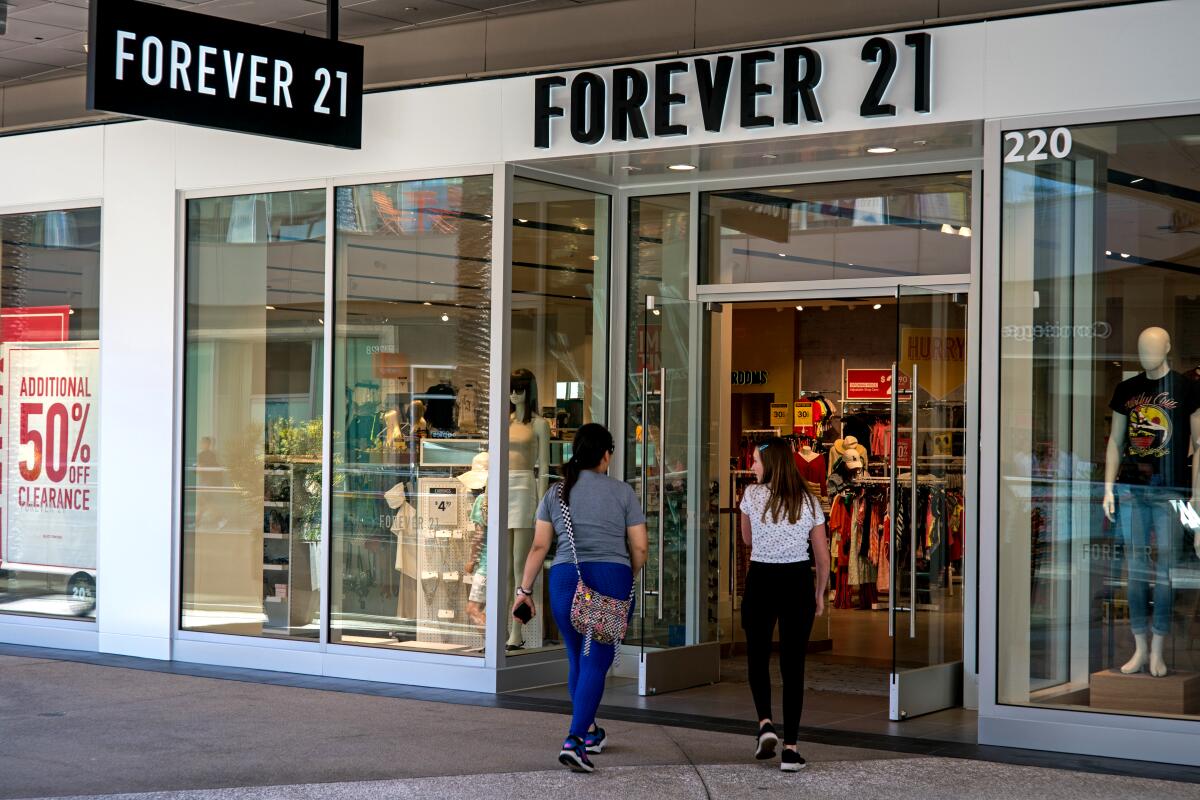Forever 21 fashion chain goes bust, adding 178 stores to retail apocalypse

- Share via
Forever 21 Inc. filed for bankruptcy, joining the growing list of fashion retailers felled by heavy competition, high rents and the defection of shoppers to online outlets.
The Chapter 11 filing on Sunday in Wilmington, Del., allows Forever 21 to keep operating while it works out a strategy to pay its creditors and turn the business around. The plan so far includes shutting 178 of its approximately 800 stores.
All told, the retailer employs about 6,400 full-time and 26,400 part-time workers, court papers show. Forever 21 said it expects to exit most of its outlets in Asia and Europe, and it will shut all of its 44 Canadian stores that provide about 2,000 jobs, according to company statements.
The filing cited 11 leases it wants to cancel for stores that haven’t opened yet, including two for Forever 21 and nine new stores for its beauty and wellness brand, Riley Rose. Giving up new Riley Rose shops dramatically cuts back on the company’s plans to expand the brand, which currently operates just 15 outlets.
The company asked U.S. Bankruptcy Judge Kevin Gross to set rules for canceling leases that would apply to stores it decides to liquidate.
Nearly a decade ago, before Instagram influencers existed, Forever 21 helped teen girls dress like their favorite celebrities, for cheap.
Forever 21 specializes in fast-fashion apparel -- trendy, cheap, quickly made knockoffs of original designs that often are worn only a few times before being given away or tossed out. Competitors include Zara, H&M and Amazon.com.
Once popular among teenagers in the 2000s for its affordable but eye-catching designs, Forever 21’s signature bright-yellow shopping bags have become a rarer sight as Generation Z consumers -- those born from 1998 onward -- shifted rapidly to e-commerce and streetwear brands.
The bankruptcy filing could help Forever 21 get rid of unprofitable stores and raise fresh funds, allowing the private, family-held company to restructure its flailing business for a new generation. In the meantime, the stores expect to honor gift cards, returns and exchanges.
Forever 21 has obtained $275 million of debtor-in-possession financing from lenders with JPMorgan Chase & Co. as agent, as well as $75 million in new capital from TPG Sixth Street Partners and its affiliated funds.
“The key to successfully effectuating this restructuring is speed and cooperation,” the company said in court papers. “Forever 21’s DIP facilities are highly conditioned on moving quickly through these cases with support from all major stakeholders, including lenders, trade vendors, and landlords.”
Bankrupt retailers face more time pressure than other companies in Chapter 11 because the law requires them to decide within 120 days which leases they will keep and which they will reject. Forever 21 said it plans to ask Gross for more time to make that decision.
Before dawn six days a week, Norma Ulloa left the two-bedroom apartment she shared with four family members and boarded a bus that took her to a stifling factory on the outskirts of downtown Los Angeles.
The bankruptcy filing followed months of discussions with stakeholders over how to salvage the business. Chief among those parties are the retailer’s biggest landlords, including mall owners Simon Property Group Inc. and Brookfield Property Partners LP.
Forever 21 held talks with Simon and Brookfield over a pre-bankruptcy deal that would have handed them a stake in the company in exchange for considerations that could have included rent forgiveness, Bloomberg News reported earlier this month. Those talks, however, broke down, and by last week the company prepared for court proceedings without a deal in hand.
The retailer is negotiating with its largest landlords to “right size” its store footprint, the company’s chief restructuring officer, Jonathan Goulding of Alvarez & Marsal, said in a court declaration. While the parties have swapped proposals, he said, they haven’t reached a deal. Just four landlords hold almost 50% of the company’s leases, he said.
Forever 21 said it owes various lenders at least $227.7 million, including $194.5 million in asset-backed loans, a $20-million term loan and unsecured debt of 950 million Philippine pesos ($18.3 million) owed to a company organized in the Philippines named Praxton Commercial Corp.
“In an age when retail, as most Americans know it, is under assault, Forever 21 intends to use these proceedings to remain viable and write a different ending from so many retail companies before it,” Goulding said. “The goal of these Chapter 11 cases is clear: emerge with a viable and feasible standalone business and keep the dream alive.”
Forever 21 hired advisors before bankruptcy to devise a turnaround. Its plan, Goulding said, includes closing money-losing stores and cutting costs at remaining ones, reducing local store delivery fleets, growing its e-commerce business and refocusing marketing on high-spending customers.
A row of old kitchen equipment is all that remains of the Red Robin restaurant that left the Irvine Spectrum Center in June.
Forever 21’s bankruptcy filing could be problematic for major U.S. mall owners, including Simon and Brookfield, because it is one of the biggest mall tenants still standing after a wave of bankruptcies. The busts emptied more than 12,000 stores in the past two years, and those vacancies may be hard to fill.
Simon counts Forever 21 as its sixth-largest tenant excluding department stores, with 99 outlets covering 1.5 million square feet as of March 31, according to a filing.
Simon and Brookfield were both listed in court papers on Forever 21’s tally of biggest unsecured creditors. The retailer doesn’t have a lot of leverage over its landlords, according to Bloomberg Intelligence, which said in a report Friday that Forever 21 accounts for just 1.4% of Simon’s annual rent.
Jin Sook and Do Won Chang started Forever 21, first called Fashion 21, in 1984 after emigrating from South Korea. Chang worked as a janitor, gas station attendant and cafe employee while Sook worked as a hairdresser, and the couple saved $11,000 over three years to start the retailer, Goulding said.
The first store, a 900-square-foot space in Highland Park, sold $700,000 of merchandise during its first year, court papers show. Forever 21 grew rapidly and employed 43,000 at its peak, boasting more than $4 billion in annual sales.
Co-founder Chang has been focused on maintaining a controlling stake in Forever 21, which hindered efforts to raise new funds. Matters are likely to be out of his hands now, with creditors typically setting the agenda in bankruptcy proceedings and major decisions subject to a judge’s approval.
More to Read
Inside the business of entertainment
The Wide Shot brings you news, analysis and insights on everything from streaming wars to production — and what it all means for the future.
You may occasionally receive promotional content from the Los Angeles Times.












